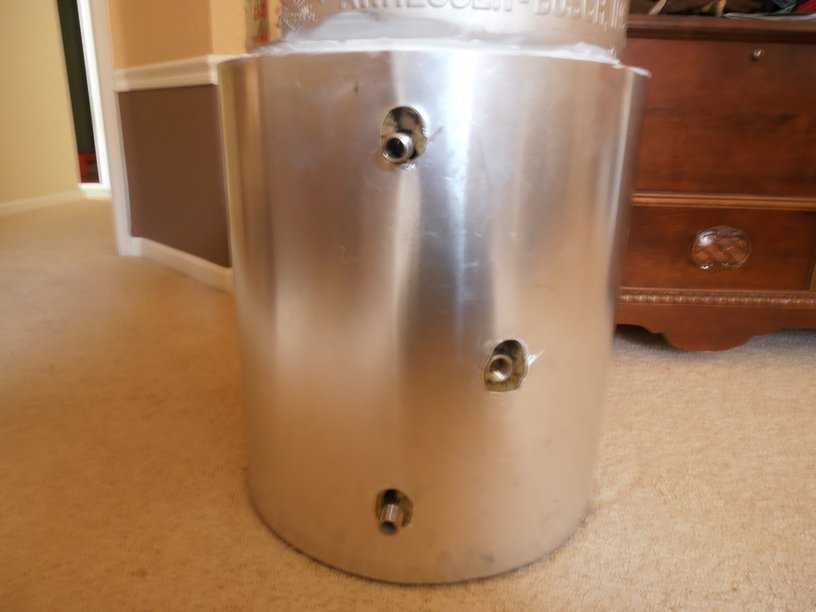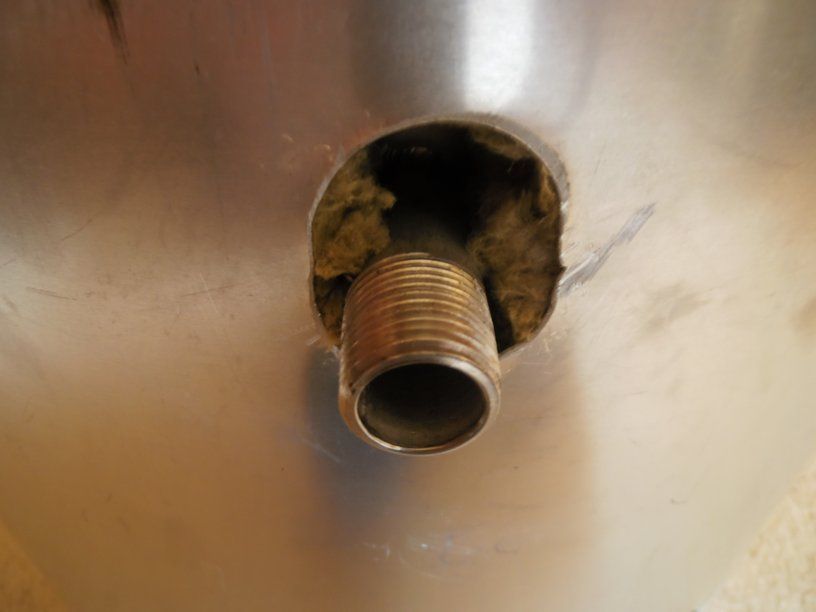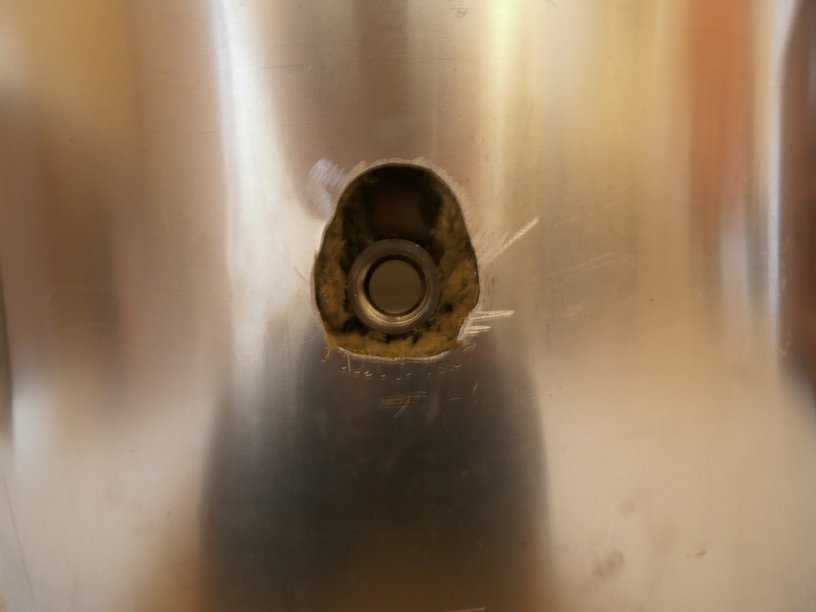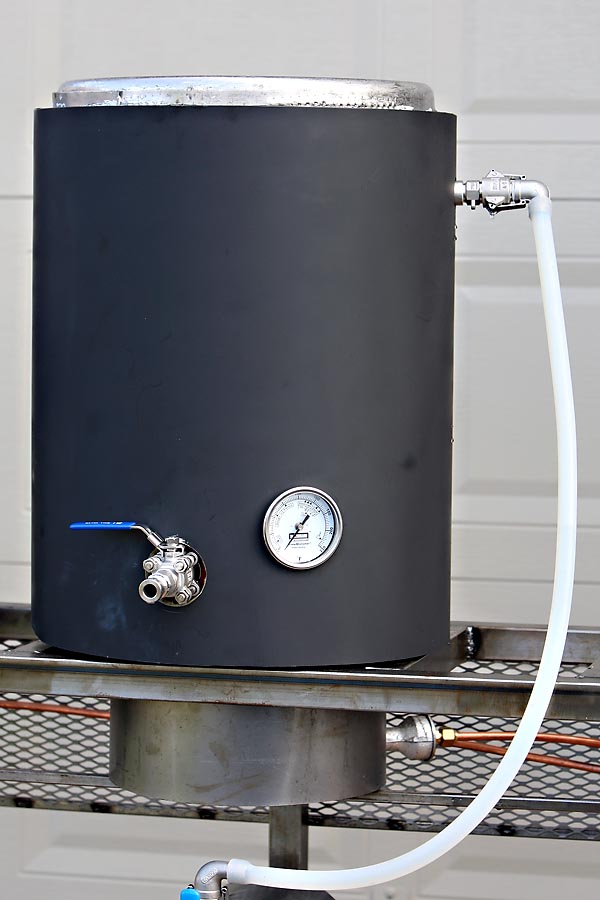Shhhhhh.
You are using an out of date browser. It may not display this or other websites correctly.
You should upgrade or use an alternative browser.
You should upgrade or use an alternative browser.
Direct Fire MLT Insulation Project
- Thread starter Bobby_M
- Start date

Help Support Homebrew Talk - Beer, Wine, Mead, & Cider Brewing Discussion Forum:
This site may earn a commission from merchant affiliate
links, including eBay, Amazon, and others.
chuckjaxfl
Well-Known Member
More seriously...
... I'm considered something like this for my e-Keggle. (Not built yet). One of your weldless sight glass kits is in the plans. Do you see a way to merge the two?
... I'm considered something like this for my e-Keggle. (Not built yet). One of your weldless sight glass kits is in the plans. Do you see a way to merge the two?
Don't do it: Zinc Metal Fume Fever : A Case Study : Blacksmithing How-to on anvilfire iForge
I actually found that link after I finished mig welding some galvanized unistrut into a brew stand in my garage. I never had any symptoms that I can tell but it's still a scary situation.
I've done a lot of welding on galvanized pieces and never had a problem. The scale of what that guy did is way beyond what you can do with a welder.
akthor
Well-Known Member
I smoke meat in a smoker I made from a galvanized trash can. You burn a couple really hot fires in it and it burns off the poisons from the galvanization. Same as with the weldless brewstands the galvanizing burns off in the first couple of brewdays.
Also as an attend um to the earlier HERMS discussion in looking around more I also came to the realization that I can fill my HLT with ice and water and use the HERMS as a chiller to cool my wort. Saving me from buying a separate chiller. Which is a bonus so even with no automation I am definitely doing a HERMS.
As an aside Bobby I want to get some stuff from your store when it's time any ideas when the camlocks will be back in stock?
Also as an attend um to the earlier HERMS discussion in looking around more I also came to the realization that I can fill my HLT with ice and water and use the HERMS as a chiller to cool my wort. Saving me from buying a separate chiller. Which is a bonus so even with no automation I am definitely doing a HERMS.
As an aside Bobby I want to get some stuff from your store when it's time any ideas when the camlocks will be back in stock?
- Joined
- Jan 4, 2009
- Messages
- 113
- Reaction score
- 4
Bobby_M said:One of the advantages to a direct fire tun is how quickly you can make temp moves. Herms relies on a single burner to apply heat to twice as much thermal mass so it's slower. The other advantage an insulated direct fire tun is that I don't have to run my pump for an hour. It runs 5 minutes during the heating and that's it.
Another aside... I was under the impression that recirculating the entire mash was a good thing, a constant vorlauf. Though, Bobby's comment leads me to believe it's only to dissipate direct fire heat. Could someone elaborate or point me to a thread on this?
IMHO, constant recirculation is a good thing for keeping the entire mash temp homogeneous but it requires an automated temp control system due to the heat loss that comes with it. My manual system would need to be babysat to know when to light the fire and it would be often if recirculating.
IMHO, constant recirculation is a good thing for keeping the entire mash temp homogeneous but it requires an automated temp control system due to the heat loss that comes with it. My manual system would need to be babysat to know when to light the fire and it would be often if recirculating.
That can be solved with a $40 PID controller and a $70 gas control valve. This setup then pretty much automates step mashes too.
pola0502ds
Well-Known Member
- Joined
- Jan 12, 2011
- Messages
- 846
- Reaction score
- 3
Yeah it's not that simple.
If it were that simple you could say a $40 PID, $20 temp probe, $10 heating element. Then you need a box to house the PID controller, switch, relay, and outlet. Fittings to mount the temp probe and heating element. If you are doing gas you need to install a pilot light.
So it's not that simple.
If it were that simple you could say a $40 PID, $20 temp probe, $10 heating element. Then you need a box to house the PID controller, switch, relay, and outlet. Fittings to mount the temp probe and heating element. If you are doing gas you need to install a pilot light.
So it's not that simple.
Yes it is.Yeah it's not that simple.
Which will replace the $60? analog thermometer.If it were that simple you could say a $40 PID, $20 temp probe
Not RIMS, direct fire. You have a burner under the pot, right ? Install a gas control valve.$10 heating element.
Then you need a box to house the PID controller, switch, relay, and outlet.
If the control panel is housed away from liquids a metal sheet will do. The PID controller has a relay already in it to turn the gas control valve on and off. You don't need an outlet. Everything runs on 120VAC like it already does, except the gas valve needs a 24VAC transformer, which you can get from any junked furnace or buy new for about $10.
It could go where your thermometer was OR it will take a Tee to mount it in the recirc line. A single Tee.Fittings to mount the temp probe
Use the burner already under it to direct fire it.and heating element.
Which is made from a short piece of 3/16" copper tubing. And which provides a lot of safety should you have a boil over that puts out the burner while you are in the house chatting up your SWMBO.If you are doing gas you need to install a pilot light.
Unless you like being a slave to your burners and brewing process ?
pola0502ds
Well-Known Member
- Joined
- Jan 12, 2011
- Messages
- 846
- Reaction score
- 3
gas shouldn't run through copper.
If I can buy everything I need for $110 then you got me.
If I can buy everything I need for $110 then you got me.
That can be solved with a $40 PID controller and a $70 gas control valve. This setup then pretty much automates step mashes too.
In my situation, I have no desire to automate using gas. The long term goal is pure electric so I'm not spending any money on an interim gas system.
gas shouldn't run through copper.
The pilot feed line in a furnace is copper. There is no pressure on it. The end vents to air.
Not trying to "get" you, but if you can made due with a single digital thermometer, then yes, it can be done.If I can buy everything I need for $110 then you got me.
The PID is here.
Amazon.com: Dual Digital Display PID Temperature Controller. Great for Sous vide: Industrial & Scientific
Here is one possible thermocouple.
http://www.amazon.com/dp/B0052IGFZ4/?tag=skimlinks_replacement-20
There are others as well.
http://www.amazon.com/dp/B005OIZTHM/?tag=skimlinks_replacement-20
http://www.amazon.com/dp/B005G14R70/?tag=skimlinks_replacement-20
The gas control valve is here.
Amazon.com: Honeywell International VR8200A2132 Gas Control Valve: Home Improvement
You'll need a kit to convert it from NG to propane if you are running propane.
Pilot thermocouple is here.
http://www.amazon.com/dp/B000BPHNW2/?tag=skimlinks_replacement-20
You'll need a few odds and ends as well, ie copper tubing for the pilot "jet", etc.
Last edited by a moderator:
In my situation, I have no desire to automate using gas. The long term goal is pure electric so I'm not spending any money on an interim gas system.
Fair enough. Each to his own.
pola0502ds
Well-Known Member
- Joined
- Jan 12, 2011
- Messages
- 846
- Reaction score
- 3
no problem man, I think thats impressive.. I can't believe it can be that cheap.
Okay, back on topic.. Sorry guys.
Okay, back on topic.. Sorry guys.
akthor
Well-Known Member
Step by step instructions please cuz if it's this cheap and easy then I will for sure do it! Not being sarcastic or anything I believe you I just wanna know how to do it, cuz I'm a little dumb when it comes to the automating stuff, I've read a ton of stuff on here but still don't have a clue 
Yes it is.
Which will replace the $60? analog thermometer.
Not RIMS, direct fire. You have a burner under the pot, right ? Install a gas control valve.
If the control panel is housed away from liquids a metal sheet will do. The PID controller has a relay already in it to turn the gas control valve on and off. You don't need an outlet. Everything runs on 120VAC like it already does, except the gas valve needs a 24VAC transformer, which you can get from any junked furnace or buy new for about $10.
It could go where your thermometer was OR it will take a Tee to mount it in the recirc line. A single Tee.
Use the burner already under it to direct fire it.
Which is made from a short piece of 3/16" copper tubing. And which provides a lot of safety should you have a boil over that puts out the burner while you are in the house chatting up your SWMBO.
Unless you like being a slave to your burners and brewing process ?
In a new dedicated thread please?
Okay looking to make a mash tun from an empty keg that I already have, but it is a Coors Keg so it is kinda rounded, can I accomplish the same insulation project with this keg or do I need to get something else? Also I do not currently have a pump, could I just vorlauf on my own while heating to avoid scorching the bottom?
Bobby - can you answer a question on how you applied the wool to the flashing?
Now did you pre curve the flashing, adhere the wool to the flashing and then install? Or did you adhere the wool to the keggle as well and then put the flashing over it? Thanks.
Now did you pre curve the flashing, adhere the wool to the flashing and then install? Or did you adhere the wool to the keggle as well and then put the flashing over it? Thanks.
It's been a while since I did it but I THINK I used the precurved flashing to push the wool around the keg. It will crack in a few places because it is semi-rigid but once you have it wrapped well, it will curve around. I did spray some 3M super 88 adhesive on the outside of the wool just so it would stay on the flashing if I needed to remove it but honestly, I don't think I'll ever take it off the keg. I know I didn't use any adhesive between the keg and wool.
It's been a while since I did it but I THINK I used the precurved flashing to push the wool around the keg. It will crack in a few places because it is semi-rigid but once you have it wrapped well, it will curve around. I did spray some 3M super 88 adhesive on the outside of the wool just so it would stay on the flashing if I needed to remove it but honestly, I don't think I'll ever take it off the keg. I know I didn't use any adhesive between the keg and wool.
When I did mine I used sheet metal that was a bit thicker and harder to work with so it was necessary to prebend it. If I had glued the wool on first I think just the amount of metal bending i was doing would have it crumbling apart.
Bend metal, spray the heck out of it with Super 88 and then use tied downs to hold the metal in place. Drills holes and pop rivot buckles on.
I too have never removed mine from my keg.
When I did mine I used sheet metal that was a bit thicker and harder to work with so it was necessary to prebend it. If I had glued the wool on first I think just the amount of metal bending i was doing would have it crumbling apart.
Bend metal, spray the heck out of it with Super 88 and then use tied downs to hold the metal in place. Drills holes and pop rivot buckles on.
I too have never removed mine from my keg.
So wait. How do you get the wool to stick to the keggle if you aren't applying adhesive to the flashing first? Also how are you strapping the flashing to the keggle and then drilling holes? Wouldn't the big bulge around the fittings cause issues?
Alright, sorry for the multiple questions. I have a piece of aluminum (22 Gauge) that's only 19" tall. I don't know why I ordered that size. So now I have about a 4" differential to the top of the keggle. With this in mind, how would you suggest I position the flashing? Leave a big gap at the top? Bottom? Or split the difference between top and bottom?
Thanks.
Thanks.
So I finally built my Bobby inspired insulated mash tun. If you see the enclosed picture I made the damn holes around my coupling too big. I had to readjust after I cut smaller ones which caused the big holes. My question is how do I cover these gaps so the wool does not get wet?
I was thinking of smaller pieces of aluminum (with the exact right size hole) that I could rivet in place. But I will still have some leakage without silicon caulking or something. My concern is that at the bottom of the kettle temps might get high enough to melt the silicon? Not sure what kind of temp range the silicon could handle or whether the bottom of the aluminum sheeting gets hot enough to even worry about it?
Would there be any other type of waterproof adhesive that can handle high temps?
Any suggestions would be greatly appreciated.



I was thinking of smaller pieces of aluminum (with the exact right size hole) that I could rivet in place. But I will still have some leakage without silicon caulking or something. My concern is that at the bottom of the kettle temps might get high enough to melt the silicon? Not sure what kind of temp range the silicon could handle or whether the bottom of the aluminum sheeting gets hot enough to even worry about it?
Would there be any other type of waterproof adhesive that can handle high temps?
Any suggestions would be greatly appreciated.



Good to know about the silicon not burning. I think I will use the aluminum sheating to cover the gaps. Maybe I can get away with just using the silicon to hold the aluminum in place and not need rivets?
Huaco
Well-Known Member
My question is how do I cover these gaps so the wool does not get wet?
If you have any sheet metal left, you could cut large donuts with the outside diameter (OD) being big enough to cover the largest of the holes. Cut the inside diameter (ID) to a nice tight fit over your pipe nipples. Drill some holes in the donuts and the sheet metal and rivet those on with some blind rivets. If you are concerned about water infiltration, you could run a bead of silicon around the inside face of the donuts prior to riveting them.
I agree that cutting some "donut" trim pieces would hide those holes just fine. You could rivet them on or just use a smear of silicone.
The term "blind rivet" is synonymous to pop rivets or what everyone pretty much understands as a rivet. There are other types that have to be cinched together with pressure from both sides. A pop rivet can be installed when one side is inaccessible or "blind".
The term "blind rivet" is synonymous to pop rivets or what everyone pretty much understands as a rivet. There are other types that have to be cinched together with pressure from both sides. A pop rivet can be installed when one side is inaccessible or "blind".
BrewHogDeluxe
Well-Known Member
Even though I am not direct firing my RIMS, I am watching for ideas on insulating my RIMS controlled MLT.
Have you seen the Keg Kozy? I saw it on here the other day, checked it out $39.95. Neoprene 7mm, keeps a keg cold for 6 hours and there are some homebrewer reviews on their website about using it on your MLT.
Getting ready to build my AG setup and I think I will try this on my MLT for temp stability.
You just can't direct fire on a keg kozy so it's not necessarily relevant to this thread (not that it doesn't have merit in its own right).
BrewHogDeluxe
Well-Known Member
You just can't direct fire on a keg kozy so it's not necessarily relevant to this thread (not that it doesn't have merit in its own right).
Oops somehow missed the direct fired part.


This still holding up, Bobby?
Wonder how it would work out if I wrapped a keg with no holes, and then drilled them. Probably just have to open up the holes in the flashing to accommodate the fittings.
It looks brand new still.
Similar threads
- Replies
- 13
- Views
- 3K
- Replies
- 2
- Views
- 1K

